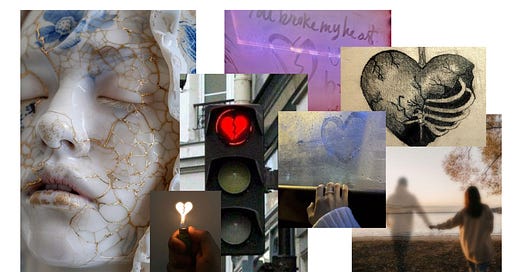There is a crack in everything / That’s how the light gets in — Leonard Cohen, Anthem
Hearts are made to be broken — Oscar Wilde, De Profundis
Some things are meant to be broken. These include: fortune cookies, world records, wishbones, wax seals, eggs, geodes, ice cubes, hearts. Also, sometimes, tea bowls.
According to folklore, there was once a shogun called Ashikaga Yoshimasa, whose internal world almost collapsed when his favourite Chinese tea bowl was broken. Sending it to China to be repaired, it came back to him mended with staples, lots of tiny holes drilled into each side of the break. But this shogun liked beautiful things. So he had the Japanese craftspeople find a way of mending that was also aesthetically pleasing. A method that didn’t deny the object’s history, but celebrated it instead. Thus, kintsugi was born.
According to folklore™, every young woman will have at least one devastating heartbreak in her life. And as she experiences it, she’ll find objects and attach stories to them. The mundane will be transformed into orbs of meaning. Toast will be inedible because of that time she ate toast with her lover and he told her the way she chewed was adorable and afterwards they made love amidst crumby sheets and she didn’t even mind, which is so unlike her. Whole albums will become weighed down, pregnant with meaning. The first song she listened to and thought of him. The song he said was ‘actually quite good’ after a sceptical eye-roll at its title. The song on the radio as she drove to see him, back when she never thought it would ever end. And then there’s the inescapable things. Traffic lights. Coffee orders (he liked flat whites). Pumpkin soup. High heels on cobbled stones. The sound of rain on the window.
It was that kind of heartbreak – the devastating, unforgettable kind that follows you around like a shadow as you run your errands and hang your washing – that introduced me to the concept of kintsugi. Well, actually, it was my mum. She gave me a small china bowl, breaks streaked with gold. Told me, her voice soft, that just because something breaks doesn’t mean it’s unfixable. Lana Del Rey has a song about it. So does Leonard Cohen, but I’ll get onto that later. She sings: ‘I don’t trust myself with a broken heart / But I’ve had to let it break a little more.’ Why? Because it’s ‘how the light gets in.’ How shards of gold beam their way into the darkness.
Now, five years later, that bowl sits on my bookshelf, in the flat I share with my partner and our cat. We keep spare change in it, dip into it whenever one of us needs a pound coin for the supermarket, or a gym locker. For long stretches of time, I forget it’s there. When something particularly devastating happens, I remember. Some things really are meant to be broken.
The quote ‘hearts are made to be broken’ is often attributed to Oscar Wilde without its context. The full quote is actually: ‘The most terrible thing about it is not that it breaks one’s heart – hearts are made to be broken – but that it turns one’s heart to stone’ (De Profundis). Because yes, of course. (The penny drops, like a rusted church bell into glassy water). It’s not actually heartbreak we should fear: it’s apathy.
Keep reading with a 7-day free trial
Subscribe to Notes On 💌 to keep reading this post and get 7 days of free access to the full post archives.





